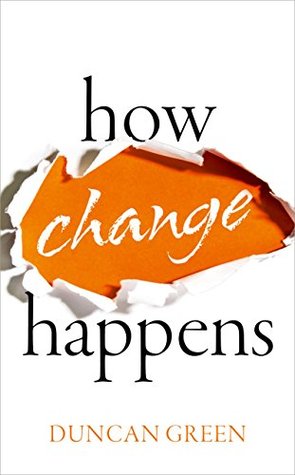 How Change Happens is an ambitious book that not only aims to explain the mechanisms behind change, but also to provide change-makers a blueprint they can use to effect change. I'm going to be honest and say that this book impressed me from the introduction, so I'm probably pretty biased. The author starts out by admitting that:
How Change Happens is an ambitious book that not only aims to explain the mechanisms behind change, but also to provide change-makers a blueprint they can use to effect change. I'm going to be honest and say that this book impressed me from the introduction, so I'm probably pretty biased. The author starts out by admitting that:"[I]n the end, this is a book written by a white, Western (and rapidly aging) male, and it inevitably echoes my experiences, networks, culture, assumptions, and prejudices. Please don't forget that, while you're reading it. "Consider how rare it is for people to admit their bias, I was immediately impressed by this, and had a pretty good feeling of this book. Because while a lot of people like to call on others to "check your privilege", they rarely check their own privileges (unless it's to brag/make a point, which is also not that common)
The book basically introduces and explains what the author calls a "power and systems approach". Basically, a PSA works two ways: looking backwards at past stories of change to see what kind of questions should be ask, and to avoid "the tendency to think that whatever changed was 100 per cent down to the activists concerned", and looking forwards, because "a PSA acknowledges we can't anticipate those critical junctures, so it is essential to 'expect the unexpected' by putting good feedback and response systems in place."
Part one is an introduction, looking at system thinking, how power lies at the heart of change (and the different types of power and changes that can happen) as well as looking at how shifts in social norms often underpin change. The case study was on the Chiquitanos of Bolivia. I had lots of highlights, but I wanted to share this:
"Unfortunately, the way we commonly think about change projects onto the future the neat narratives we draw from the past. Many of the mental models we use are linear plans - "if A, then B"- with profound consequences in terms of failure, frustration, and missed opportunities. "Part 2 is on the how states evolve, how laws can be very effective in getting real change happening, how media and politics work, and to what extent the international system shapes change. And a chapter on transnational corporations and how they affect change. The case study for this is on the December 2015 Paris Agreement on Climate Change.
Part 3 focuses on activists, leaders, and advocacy, and I was surprised to see Lee Kuan Yew mentioned, though not really discussed. But out of the three chapters in this section, I really liked this section in the chapter on leadership, because it sums up the different between feminine and feminist approaches to leadership very well:
"A feminine approach to leadership recognises that women often bring a greater attention to collaboration, collective decision making, and building relationships, characteristics that fall well within the traditional gendered roles of women. In contrast, a feminist approach seeks to transform relations of power, paying close attention to 'power within' and 'power with', as well as hidden and invisible power."The last section is basically a summary of the whole thing.
The narrative style reminds me of an interesting lecture. It's formal, but readable and occasional moments of humour. Plus, the author manages to work in the phrase 'conscious uncoupling' which made me laugh. The author also draws on his experiences too, which I found very illuminating.
"Western campaigners tend to dumb down the complex realities of messy conflicts into simple narratives of good and bad to be remedied by simple solutions (preferably delivered by the West). Such narratives squeeze out the more nuanced views of local people and the deeper, underlying causes of conflict, and end up promoting superficial victories rather than real change. "
In conclusion, if you are interested in learning how change works, or if you're interested in effecting some change yourself, then you should definitely read this book. While it's not a step-by-step manual, it does explain things in a way that shows you the path you should be taking.
Disclaimer: I got a free copy of this book from the publisher via NetGalley in exchange for a free and honest review.

No comments :
Post a Comment
I really do appreciate all comments, and I'll try my best to reply within 24 hours!
^_^